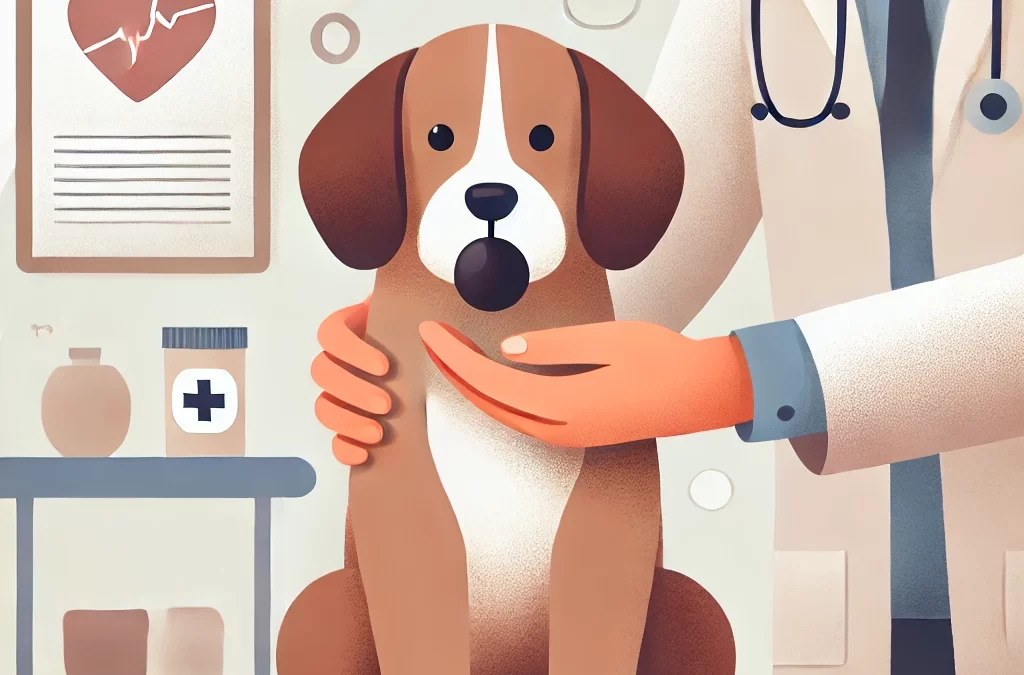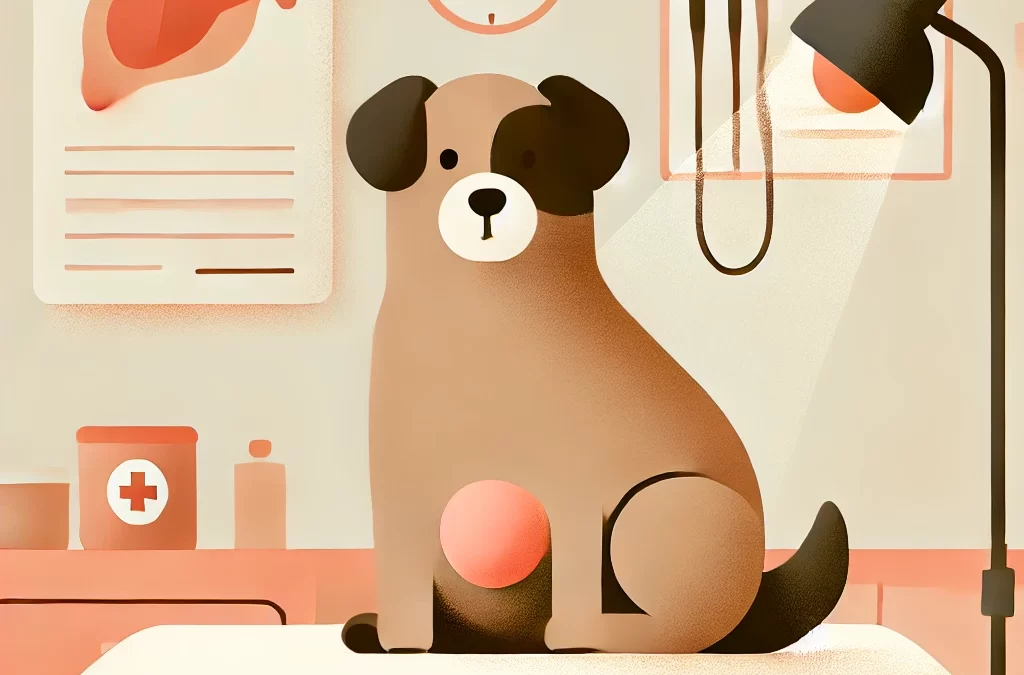
par TCMVET | 20 décembre 2024 | Cancer et tumeurs du chien
Le cancer chez les chiens est depuis longtemps un sujet de préoccupation pour les propriétaires d'animaux de compagnie. Bien qu'il soit naturel de se sentir dépassé face à ce diagnostic, comprendre les causes peut offrir des indications sur la prévention et les soins. Cet article se penche sur les raisons potentielles du cancer chez les chiens, mettant en lumière les facteurs génétiques, environnementaux et liés au mode de vie.
Prédisposition génétique : un facteur silencieux
L’une des principales raisons pour lesquelles les chiens développent un cancer est la génétique. Certaines races sont plus sujettes au cancer en raison de traits héréditaires. Par exemple, les Golden Retrievers, les Boxers et les Rottweilers sont connus pour avoir une probabilité plus élevée de développer des cancers tels que le lymphome et l’ostéosarcome. Cette prédisposition génétique souligne l’importance de pratiques d’élevage responsables pour minimiser les risques.
Toxines environnementales : des menaces invisibles
Les chiens sont souvent exposés à des toxines environnementales sans que leurs propriétaires ne s'en rendent compte. Les pesticides, les herbicides, la fumée secondaire et même les produits d'entretien ménager peuvent contribuer au développement du cancer. Une exposition prolongée à ces substances nocives peut déclencher des mutations dans les cellules, conduisant éventuellement à la croissance de tumeurs.
Alimentation et obésité : nourrir le risque
Une alimentation pauvre en nutriments essentiels ou riche en aliments transformés peut affaiblir le système immunitaire d'un chien, le rendant plus vulnérable au cancer. L'obésité aggrave encore le problème en créant un environnement inflammatoire dans le corps. Maintenir une alimentation équilibrée riche en antioxydants et éviter la suralimentation peut réduire considérablement le risque.
Le vieillissement : un facteur naturel
À mesure que les chiens vieillissent, leurs cellules subissent une usure qui augmente le risque de cancer. Les chiens plus âgés subissent souvent un déclin de la fonction immunitaire, ce qui permet aux cellules anormales de proliférer sans contrôle. Des contrôles vétérinaires réguliers sont donc essentiels pour une détection et une intervention précoces.
Survaccination et facteurs médicaux
Certaines études suggèrent que la survaccination ou les procédures médicales inutiles pourraient jouer un rôle dans l'augmentation du risque de cancer. Si les vaccins sont essentiels pour prévenir les maladies, des vaccinations excessives ou mal programmées peuvent mettre à rude épreuve le système immunitaire d'un chien. Consultez toujours un vétérinaire de confiance pour élaborer un plan de vaccination adapté aux besoins de votre chien.
Exposition au soleil et dommages causés par les UV
Chez les chiens à fourrure claire ou fine, une exposition excessive au soleil peut entraîner un cancer de la peau, en particulier dans les zones peu pigmentées. Protégez votre chien avec une crème solaire sans danger pour les animaux ou limitez les activités en extérieur pendant les heures de pointe du soleil.
Comment minimiser les risques
- Alimentation équilibrée : Offrez à votre chien une alimentation de qualité adaptée à son âge, à sa race et à son niveau d'activité. Incluez des sources naturelles d'antioxydants, comme les myrtilles et les carottes.
- Limiter l’exposition aux toxines : Utilisez des produits de nettoyage sans danger pour les animaux et évitez d’exposer votre chien aux pesticides ou à la fumée de tabac.
- Exercice régulier: Maintenez un poids santé grâce à une activité physique régulière.
- Visites de routine chez le vétérinaire : Planifiez des examens et des dépistages annuels pour détecter rapidement d’éventuels problèmes de santé.
- Plans de vaccination personnalisés : Travaillez avec votre vétérinaire pour élaborer un calendrier de vaccination adapté au mode de vie et au profil de santé de votre chien.
Pensées finales
Le cancer chez le chien est une maladie complexe influencée par un mélange de facteurs génétiques, environnementaux et de style de vie. Bien qu'il soit impossible d'éliminer tous les risques, la prise de mesures proactives peut réduire considérablement la probabilité de cancer. En restant informés et attentifs, les propriétaires d'animaux peuvent offrir à leurs compagnons à quatre pattes les meilleurs soins et la meilleure qualité de vie possible.

par TCMVET | 18 décembre 2024 | Cancer et tumeurs du chien
Le lymphome est l'un des cancers les plus courants chez les chiens. Bien qu'il soit souvent possible de le gérer grâce à des traitements comme la chimiothérapie, il arrive un moment où la maladie peut progresser malgré les interventions. Reconnaître les signes indiquant que votre chien approche de la fin de son parcours peut vous aider à le réconforter et à prendre des décisions éclairées concernant ses soins. Voici un guide pour comprendre les signes du lymphome à un stade avancé et comment soutenir votre animal de compagnie bien-aimé pendant cette période difficile.
Comprendre le lymphome canin
Le lymphome affecte le système lymphatique, qui fait partie du système immunitaire. Il peut se manifester dans différentes parties du corps, notamment les ganglions lymphatiques, la rate, le foie et le tube digestif. La progression de la maladie varie, mais à mesure qu'elle progresse, le corps devient de plus en plus compromis, ce qui entraîne des changements physiques et comportementaux importants.
Signes indiquant que votre chien est peut-être en train de mourir d'un lymphome
Fatigue intense et léthargie
Les chiens atteints d'un lymphome avancé présentent souvent une fatigue extrême. Votre animal autrefois actif peut passer la majeure partie de sa journée à dormir ou à s'allonger, montrant peu d'intérêt pour les activités qu'il aimait auparavant.
Difficulté à respirer
Un lymphome au niveau de la poitrine peut provoquer une accumulation de liquide autour des poumons, ce qui rend la respiration difficile pour votre chien. Les signes incluent une respiration rapide, une respiration superficielle ou un effort pénible.
Perte d'appétit
Un chien mourant peut refuser de manger ou de boire, ce qui indique que son corps est en train de s'éteindre. Même ses friandises préférées peuvent rester inutilisées.
Perte de poids et fonte musculaire
Au fur et à mesure que la maladie progresse, une perte de poids importante et une atrophie musculaire (cachexie) deviennent évidentes. Les côtes et la colonne vertébrale du chien peuvent devenir plus prononcées.
Des ganglions lymphatiques enflés
Bien que les ganglions lymphatiques gonflés soient un signe caractéristique du lymphome, leur taille peut augmenter considérablement à mesure que la maladie approche de ses stades finaux.
Vomissements et diarrhée
Si le lymphome affecte le tractus gastro-intestinal, votre chien peut souffrir de vomissements chroniques, de diarrhée ou des deux. Ces symptômes peuvent entraîner une déshydratation et affaiblir davantage l'organisme.
Douleur et inconfort
Votre chien peut présenter des signes de douleur, comme des gémissements, des difficultés à se coucher ou une réticence à bouger. La douleur peut résulter d'une lésion organique, d'une inflammation ou d'une pression causée par des tumeurs.
Changements de comportement
Les chiens ont tendance à se replier sur eux-mêmes à l'approche de la fin de leur vie. Ils peuvent éviter toute interaction, rechercher la solitude ou paraître désorientés.
Comment soutenir votre chien pendant cette période
Consultez votre vétérinaire pour vous assurer que votre chien bénéficie d'une gestion adéquate de la douleur et de soins palliatifs. Des médicaments comme des anti-nauséeux, des stimulants de l'appétit et des analgésiques peuvent améliorer le confort de votre chien.
Créez un environnement calme et paisible où votre chien peut se reposer sans être dérangé. Offrez-lui une literie moelleuse et gardez ses objets préférés à proximité.
Offrez-lui de petites quantités de nourriture facilement digestible si elle le souhaite. L'hydratation est également importante, mais ne le forcez pas à boire.
Passez du temps de qualité avec votre animal de compagnie, en lui offrant une douce affection et en le rassurant. Être présent peut apporter un immense réconfort à vous et à votre chien.
Envisagez l'euthanasie humaine si la qualité de vie de votre chien diminue considérablement. Bien qu'il s'agisse d'une décision difficile, cela peut être une façon compatissante d'atténuer ses souffrances.
Conclusion
Reconnaître les signes indiquant que votre chien est peut-être en train de mourir d'un lymphome vous permet de vous concentrer sur son confort et son bien-être. Le parcours de chaque chien est unique, et votre amour et vos soins pendant cette période feront une différence significative dans ses derniers jours.

par TCMVET | 18 décembre 2024 | Cancer et tumeurs du chien
Introduction : L’ennemi silencieux dans les soins aux chiens atteints de cancer
La cachexie cancéreuse, un syndrome métabolique complexe caractérisé par une perte de poids importante et une atrophie musculaire, est une maladie silencieuse mais mortelle qui touche de nombreux chiens atteints de cancer. Souvent éclipsée par la maladie primaire, la cachexie a un impact significatif sur la qualité de vie, la réponse au traitement et la survie globale des animaux affectés. Comprendre et traiter cette maladie est essentiel pour une prise en charge holistique du cancer chez les chiens.
What is Cancer Cachexia?
La cachexie cancéreuse ne se résume pas à une simple perte de poids. Il s'agit d'une affection multifactorielle provoquée par l'interaction entre l'inflammation systémique, la dysrégulation métabolique et les exigences métaboliques de la tumeur. Les principales caractéristiques sont les suivantes :
- Perte de masse musculaire:Contrairement à la simple famine, la cachexie entraîne une perte musculaire qui ne peut pas être inversée par une augmentation de l’apport calorique seule.
- Appetite Changes:Les chiens peuvent montrer un intérêt réduit pour la nourriture (anorexie) ou des préférences gustatives altérées.
- Inflammation systémique:L’inflammation induite par la tumeur exacerbe les déséquilibres métaboliques, aggravant encore la situation.
Pourquoi la cachexie cancéreuse survient-elle chez les chiens ?
Les mécanismes exacts de la cachexie cancéreuse sont complexes et varient en fonction du type et du stade du cancer. Les facteurs contribuant à cette pathologie sont les suivants :
- Tumor Metabolism:Certaines tumeurs sécrètent des substances qui interfèrent avec les processus métaboliques normaux, provoquant une dégradation des muscles et des graisses.
- Cytokines et hormones:L’augmentation des niveaux de cytokines pro-inflammatoires (par exemple, TNF-alpha) et les déséquilibres hormonaux jouent un rôle essentiel dans la cachexie.
- Déficiences nutritionnelles:Une diminution de l’apport alimentaire et une mauvaise absorption des nutriments aggravent l’état du chien.
Reconnaître la cachexie cancéreuse chez le chien
La détection précoce est essentielle pour gérer la cachexie cancéreuse. Recherchez les signes suivants :
- Perte de poids inexpliquée malgré un apport alimentaire adéquat
- Atrophie musculaire, notamment au niveau de la colonne vertébrale et des pattes arrière
- Fatigue et niveaux d’activité réduits
- Changements dans l'appétit ou le comportement alimentaire
Stratégies de gestion innovantes
Bien qu'il n'existe pas de solution universelle, une approche multimodale peut aider à gérer la cachexie chez les chiens. Voici quelques stratégies émergentes :
- Soutien nutritionnel personnalisé:Une alimentation riche en protéines de haute qualité, en acides gras oméga-3 et en acides aminés spécifiques comme la glutamine peut aider à préserver la masse musculaire.
- Appetite Stimulants:Des médicaments comme la mirtazapine ou la capromoréline peuvent améliorer l’appétit et l’apport alimentaire.
- Anti-Inflammatory Therapies:Les suppléments d’oméga-3 et les médicaments ciblant les voies inflammatoires peuvent réduire l’activité des cytokines.
- Modulateurs métaboliques:Les recherches sur des médicaments comme l’anamoréline et les imitateurs de la ghréline semblent prometteuses pour inverser la fonte musculaire.
Le rôle de la médecine intégrative
Les thérapies naturelles, comme la médecine traditionnelle chinoise (MTC), ont montré leur potentiel pour soulager les symptômes. Des plantes comme l'astragale et le ginseng peuvent soutenir la fonction immunitaire et les niveaux d'énergie, tandis que l'acupuncture peut améliorer l'appétit et réduire l'inflammation.
Perspectives d'avenir : la nécessité de poursuivre les recherches
Malgré les progrès réalisés, la cachexie cancéreuse reste peu étudiée en médecine vétérinaire. Les efforts de collaboration entre vétérinaires, chercheurs et propriétaires d'animaux de compagnie sont essentiels pour développer de nouvelles thérapies et améliorer les résultats pour les chiens affectés.
Conclusion : l’espoir passe par l’innovation
Bien que la cachexie cancéreuse pose des défis importants, les progrès réalisés dans la compréhension et la gestion de cette maladie offrent de l’espoir. En adoptant une approche holistique et proactive, nous pouvons améliorer la qualité de vie des chiens qui luttent contre le cancer et les aider à profiter de leurs années d’or avec dignité et confort.

par TCMVET | 16 décembre 2024 | Cancer et tumeurs du chien
Le mélanome malin de la cavité buccale (OMM) chez le chien est un adversaire furtif. Connu pour sa nature agressive et sa propagation rapide, ce diagnostic suscite la peur chez les propriétaires d'animaux de compagnie. Mais l'OMM est plus qu'une simple maladie : c'est un appel à l'action pour que les propriétaires d'animaux de compagnie adoptent la vigilance, l'innovation et les soins holistiques. Plongeons dans ce sujet difficile avec un regard neuf, en explorant à la fois la science et l'espoir.
Qu’est-ce que le mélanome malin de la bouche ?
Le mélanome malin de la bouche est un type de cancer qui prend naissance dans les mélanocytes, des cellules responsables de la production de pigments dans la peau et les muqueuses. Bien qu'il apparaisse le plus souvent dans la bouche, ce cancer ne s'arrête pas là. Il est connu pour sa capacité à envahir les tissus voisins et à métastaser vers des organes distants comme les poumons et les ganglions lymphatiques.
Cette affection est plus fréquente chez les chiens d'âge moyen et plus âgés, en particulier chez les races aux gencives pigmentées foncées, comme les Cockers Spaniels, les Chow Chows et les Scottish Terriers. Malgré sa réputation sinistre, la compréhension des signes et des options de traitement de l'OMM peut permettre aux propriétaires de prendre des décisions éclairées.
Reconnaître les signes
Le mélanome malin de la cavité buccale passe souvent inaperçu jusqu'à ce qu'il soit à un stade avancé, ce qui rend les examens bucco-dentaires réguliers essentiels. Les signes courants comprennent :
- Une masse sombre ou irrégulière dans la bouche, les gencives ou les lèvres.
- Saignement, mauvaise haleine ou bave.
- Difficulté à manger, à mâcher ou à avaler.
- Gonflement du visage ou ganglions lymphatiques hypertrophiés.
Si vous constatez l'un de ces symptômes, consultez immédiatement votre vétérinaire. Une détection précoce peut avoir un impact significatif sur les résultats.
Au-delà des traitements traditionnels : adopter l’innovation
Les traitements conventionnels de l'OMM comprennent la chirurgie, la radiothérapie et la chimiothérapie. Bien qu'efficaces dans de nombreux cas, ces options ne sont pas toujours accessibles ou abordables. Voici quelques approches innovantes et intégratives qui suscitent l'attention :
- Vaccins d'immunothérapie : Les vaccins spécifiques à l'OMM, comme le vaccin contre le mélanome canin (ONCEPT®), révolutionnent le domaine de l'oncologie en stimulant le système immunitaire du chien pour lutter contre les cellules cancéreuses. Ce traitement de pointe s'est révélé prometteur pour prolonger la durée de survie.
- Thérapie photodynamique (PDT) : Cette technique utilise des médicaments activés par la lumière pour détruire les cellules cancéreuses de manière sélective, en épargnant les tissus sains environnants. Il s'agit d'une option moins invasive dans certains cas.
- Compléments alimentaires holistiques : Les compléments naturels comme la curcumine (présente dans le curcuma), les champignons médicinaux et les acides gras oméga-3 sont étudiés pour leurs propriétés anti-inflammatoires et stimulantes du système immunitaire. Consultez toujours un vétérinaire avant d'incorporer des compléments.
Le rôle de l’alimentation dans la guérison
Un diagnostic de cancer nécessite un changement de stratégie alimentaire. Les chiens qui luttent contre l'OMM bénéficient d'un régime alimentaire adapté à leurs besoins métaboliques. Focus sur :
- Protéines de haute qualité : Viandes maigres et poissons pour maintenir la masse musculaire.
- Graisses saines : Acides gras oméga-3 pour combattre l’inflammation et soutenir la santé globale.
- Options à faible teneur en glucides : Les cellules cancéreuses se nourrissent de sucre ; limiter les glucides peut aider à ralentir leur croissance.
Les repas faits maison, approuvés par un vétérinaire, peuvent être un excellent moyen de garantir que votre chien reçoit une nutrition optimale.
Soutien émotionnel et pratique pour les propriétaires d'animaux de compagnie
Prendre soin d'un chien atteint d'OMM est aussi exigeant sur le plan émotionnel que difficile. Voici comment gérer ce parcours :
- Créez une routine de soins quotidienne : Établir une cohérence peut aider à réduire le stress pour vous et votre chien.
- Rechercher le soutien de la communauté : Les forums en ligne et les groupes de soutien locaux pour les propriétaires d’animaux de compagnie confrontés au cancer canin peuvent apporter du réconfort et des informations précieuses.
- Explorez les options de soins palliatifs : Si le traitement curatif n’est pas une option, concentrez-vous sur la gestion de la douleur et l’amélioration de la qualité de vie de votre chien.
Une lueur d'espoir
Le mélanome malin buccal chez le chien est un ennemi redoutable, mais les progrès de la médecine vétérinaire et des soins intégratifs changent la donne. La détection précoce, les traitements innovants et l'accent mis sur le bien-être holistique permettent aux propriétaires d'animaux de compagnie de lutter contre cette maladie.
Le diagnostic de votre chien ne définit pas le parcours du chien, c'est un chapitre de l'histoire de sa résilience, de son amour et du lien que vous partagez. Continuez à poser des questions, à chercher des solutions et à chérir chaque instant.

par TCMVET | 16 décembre 2024 | Cancer et tumeurs du chien
La découverte d'une grosseur sur le ventre de votre chien peut être alarmante. En tant que propriétaires d'animaux de compagnie, notre premier réflexe est souvent de nous inquiéter, mais toutes les grosseurs ne sont pas dangereuses. En fait, beaucoup sont bénignes et gérables avec des soins appropriés. Pour vous aider à gérer cette situation, voici une nouvelle perspective sur la compréhension, l'identification et le traitement des grosseurs gastriques chez les chiens.
Qu’est-ce qu’une grosseur d’estomac exactement ?
Une grosseur abdominale chez le chien désigne toute masse anormale ou gonflement dans la région abdominale. Celles-ci peuvent varier en taille, en forme et en texture : certaines sont molles et mobiles, tandis que d'autres peuvent être fermes ou attachées aux tissus sous-jacents.
La clé pour traiter ces excroissances réside dans l'observation et l'action rapide. Avant de tirer des conclusions hâtives, explorons les causes les plus courantes de ces excroissances.
Causes courantes des bosses d’estomac
- Lipomes (tumeurs graisseuses) : Il s'agit de tumeurs bénignes, molles et à croissance lente que l'on retrouve généralement chez les chiens âgés. Les lipomes présentent rarement un risque pour la santé et sont généralement davantage un problème esthétique.
- Hématomes ou abcès : Si votre chien a récemment subi un traumatisme, la grosseur pourrait être un hématome (accumulation de sang sous la peau) ou un abcès causé par une infection. Ces lésions sont souvent chaudes et sensibles au toucher.
- Hernies : Les hernies se produisent lorsque des tissus ou des organes internes pénètrent dans un point faible de la paroi abdominale. Elles peuvent être molles et se réduire lorsqu'on appuie doucement dessus.
- Tumeurs malignes: Malheureusement, certaines tumeurs sont cancéreuses. Les tumeurs des mastocytes, les sarcomes des tissus mous et d'autres tumeurs malignes nécessitent souvent une attention et un traitement vétérinaire rapides.
- Kystes ou excroissances des glandes sébacées : Il s'agit souvent de poches remplies de liquide ou de glandes obstruées qui peuvent apparaître sur l'estomac de votre chien. Elles sont généralement inoffensives, mais peuvent nécessiter un drainage ou une intervention chirurgicale mineure si elles deviennent trop grosses.
Signes qui nécessitent une attention immédiate
Même si toutes les bosses dans l’estomac ne sont pas préoccupantes, certains symptômes signalent la nécessité d’une visite urgente chez le vétérinaire :
- La grosseur grossit rapidement.
- Votre chien semble ressentir de la douleur lorsque la zone est touchée.
- La masse est dure, immobile ou de forme irrégulière.
- Il y a une rougeur, un gonflement ou un écoulement au niveau de la zone.
- Votre chien montre des signes de léthargie, de perte d’appétit ou d’autres problèmes systémiques.
Que faire si vous découvrez une bosse
- Surveiller la grosseur : Gardez une trace de sa taille, de sa texture et de son comportement. Prendre des photos tous les deux ou trois jours peut vous aider à noter tout changement.
- Planifier une visite chez le vétérinaire : Votre vétérinaire peut effectuer un examen physique et peut recommander des tests diagnostiques tels qu'une aspiration à l'aiguille fine, une biopsie ou une échographie pour déterminer la nature de la masse.
- Envisager des options de traitement : En fonction du diagnostic, votre vétérinaire peut suggérer une observation, des médicaments, une intervention chirurgicale ou d'autres thérapies. Pour les excroissances bénignes comme les lipomes, le traitement peut ne pas être nécessaire, sauf si la grosseur provoque une gêne.
- Découvrez les remèdes naturels (avec l'approbation du vétérinaire) : Pour les tumeurs non malignes, certains propriétaires d'animaux se tournent vers des compléments naturels comme le curcuma, les acides gras oméga-3 ou les traitements à base de plantes qui favorisent la santé immunitaire globale. Consultez toujours votre vétérinaire avant d'introduire un nouveau complément.
Conseils de prévention pour un chien en bonne santé
- Contrôles réguliers : Une détection précoce est essentielle pour gérer efficacement les grosseurs. Des visites régulières chez le vétérinaire permettent de s'assurer que tout changement est traité rapidement.
- Régime équilibré: Une alimentation riche en nutriments peut soutenir la santé générale et l’immunité de votre chien.
- Maintenir un poids santé : L'obésité augmente le risque de tumeurs graisseuses et d'autres problèmes de santé. Gardez votre chien actif et à un poids idéal.
- Soins de la peau: Un toilettage et une inspection réguliers du pelage et de la peau de votre chien peuvent vous aider à détecter les anomalies à un stade précoce.
Un mot de réconfort
Toutes les tumeurs ne sont pas mortelles et les progrès de la médecine vétérinaire ont rendu le diagnostic et le traitement plus efficaces que jamais. En restant attentif et proactif, vous pouvez vous assurer que votre chien reste heureux et en bonne santé.
Si vous remarquez une boule au niveau de l'estomac, respirez profondément et contactez votre vétérinaire. Ensemble, vous trouverez la meilleure solution pour votre compagnon à quatre pattes.
Mots clés : tumeurs bénignes chez le chien, causes de tumeurs chez le chien, traitement des tumeurs chez le chien, soins de santé pour chiens, remèdes naturels pour chiens





